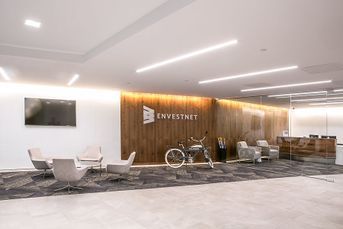The Latest In Financial Advisor #FinTech
This month's edition kicks off with the big news that former Envestnet executive Lori Hardwick is joining Riskalyze's Board of Directors.
Welcome to the April 2018 issue of the Latest News in Financial Advisor #FinTech – where we look at the big news, announcements, and underlying trends and developments that are emerging in the world of technology solutions for financial advisors and wealth management!
This month’s edition kicks off with the big news that former Envestnet executive Lori Hardwick is joining Riskalyze’s Board of Directors, almost 2 years to the day after she left Envestnet (and the end of a likely-2-year non-compete requirement!?), and just as Riskalyze increasingly pivots towards a more holistic advisor platform that puts it on competitive collision course with Envestnet itself… especially if Riskalyze is paired with the next generation advisor dashboard that Hardwick’s own start-up AI (Advisor Innovation) Labs is reportedly creating?
From there, the latest highlights also include a number of interesting advisor technology announcements, including:
• Tamarac launches a new QuickStart platform in an attempt to expedite the onboarding process for breakaway brokers who need to get up-and-running quickly;
• Orion Advisor Services expands into compliance technology solutions to ease the burden of RIAs for both ongoing compliance oversight and especially the increasingly-frequent SEC examination;
• RobustWealth launches its own Direct Indexing solution as Indexing 2.0 becomes the hot advisor technology topic of 2018 (following on the Model Marketplace buzz of 2017!);
• Trizic raises a $10M Series A round to accelerate the growth of its robo-advisor-for-advisors solutions in the bank channel, building on its partnership with FIS.
Read the analysis about these announcements, and a discussion of more trends in advisor technology, in this month’s column, including “document automation” provider Conga acquiring Orchestrate and Process Composer to compete with LaserApp and DocuPace on the Salesforce platform with large advisory firms, former TD executive Tom Bradley joins the advisory board of MaxMyInterest as advisor interest grows (no pun intended!) in helping clients get better yields on cash than what RIA custodians typically provide, Advizr lifts out four Morgan Stanley executives to scale up its financial planning software solution in the small broker-dealer and insurance agent marketplace (where it’s about not just the software itself, but practice management training to help them transition for salespeople to advisors), and Blueprint Income launches a new tech solution aiming to deliver Deferred Income Annuities directly to consumers as a means to build their own “Personal Pension” plans with ongoing systematic monthly contributions.
And be certain to read to the end, where we also highlight the launch of Joel Bruckenstein’s new “Virtual Exhibit Hall” that aims to not only be a comprehensive directory of advisor technology but also an advisor review site of technology solutions, and a first look at 55IP, a new investment proposal generation solution (that also aims to help facilitate portfolio implementation on the back end)!
I hope you’re continuing to find this new column on financial advisor technology to be helpful! Please share your comments at the end and let me know what you think!
*And for #AdvisorTech companies who want to submit their tech announcements for consideration in future issues, please submit to [email protected]!
Lori Hardwick Joins Riskalyze Board As It Continues To Pivot Towards Competing With Envestnet’s Advisor Platform. While most financial advisors know Riskalyze for their popular risk tolerance assessment tools, the company’s pivot in recent years to build out their Autopilot “robo-for-advisors” software, and a Model Marketplace of third-party asset managers where they can monetize not just their software solution but the asset flows across it, funded by a massive $20M venture capital raise led by FTV Capital in late 2016, makes them look less and less like “just” an advisor technology company that gets paid a software fee, and more like a holistic advisor platform that aims to compete with the likes of Envestnet by earning bps on its aggregated assets as a technology distribution channel for asset managers. And now, Riskalyze has announced the addition of Lori Hardwick to its advisory board, who had a brief stint as the COO of Pershing but spent the bulk of her career at Envestnet (since its inception) finishing as its Group President of Advisor Services, and has spent the past year building a start-up called “AI Labs” that aims to roll up and overlay all of an advisor’s software components into a unified advisor dashboard that would work across any/all custodians or broker-dealers. In other words, Hardwick spent most of her career building and overseeing a unified advisor platform that supported Envestnet’s marketplace of third-party managers, then went out to build her own next generation platform at AI (Advisor Innovation) Labs, and now is joining the advisory board of Riskalyze as it is seemingly moving to compete head-to-head against Envestnet as a holistic advisor platform that distributes third-party asset managers – a move for Hardwick that comes, probably not coincidentally, almost exactly 2 years after her departure from Envestnet (and the end of what was likely a 2-year non-compete clause). As Riskalyze CEO Aaron Klein notes, Hardwick’s value includes both her “extensive relationships with industry leaders and her deep grasp of the issues facing our institutional customers,” an indication that Riskalyze is looking to increasingly encroach on the turf of companies like Envestnet by going not just directly to advisors but to their parent company enterprises – likely broker-dealers in particular, where Riskalyze already has a deep advisor base, and has been rolling out solutions like its Compliance Cloud. Expect to see an ever-widening list of enterprise features from Riskalyze in the coming year, woven into an increasingly comprehensive advisor platform for broker-dealers (and perhaps some large RIAs that run a broker-dealer-style roll-up of lots of independent IARs)… and perhaps even an announcement someday that Riskalyze is partnering with or outright acquiring the AI Labs centralized dashboard platform altogether as it moves far beyond “just” risk tolerance assessment tools alone.
Tamarac Launches QuickStart To Ease Breakaway Broker Tech Transitions. It is becoming increasingly common for advisors to break away from their broker-dealers as the industry shifts increasingly AUM (and not broker-dealer product-based), and the necessary threshold AUM to break away in a cost-effective manner gets lower and lower. However, one of the biggest challenges of “breaking away” from a broker-dealer, especially a wirehouse, is that the moment you leave, it’s game-on to connect with and transition clients to the new firm and get them up-and-running before the departing broker-dealer marshalls its other brokers to call all your now-“former” clients to convince them to stay. Which is both difficult logistically just to call and reach all the relevant clients, and get them the necessary paperwork (for which many RIA custodians provide support/transition teams to help), and also to quickly get up-and-running on new technology and systems to actually execute the new business as clients quickly onboard. To help expedite the process, Tamarac is launching what it calls its “QuickStart” offering, intended to help get new breakaway brokers up and running on Tamarac’s performance reporting and trading/rebalancing software within 30 days, through a combination of video training tools to help expedite the learning process for staff to adopt the software, and the ability to bypass and later backfill the historical data conversion process (which is subsequently streamlined for a firm already using the system). Which is notable both for the non-trivial complication of changing the typical onboarding workflow into a performance reporting software solution to be able to get up-and-running first and then add the historical data conversion process later, but also simply as an acknowledgement of how challenging the onboarding and data conversion process really is for most advisory firms switching performance reporting tools. Have we reached the point now where the greatest way for performance reporting software solutions to differentiate is not in their ongoing features and benefits, but simply which one makes the conversion and onboarding process the least painful? And is this a model that could similarly be applied to other difficult-and-costly-to-transition technology solutions like financial planning software?
Orion Expands Platform Into Compliance And Alternative Investments Reporting. As performance reporting software enters a more mature stage of the marketplace, where virtually all advisory firms have adopted some solution, and the primary competition is either winning users away from each other, or “legacy” players like PortfolioCenter, it becomes increasingly difficult to compete on “core” features, and forces firms to expand their capabilities further. In this context, Orion announced two major new initiatives this month. The first was the rollout of an Alternative Investments reporting solution, designed to help RIAs that use a blend of public (e.g., market-traded) and private (e.g., private equity, hedge funds, etc.) investments to more easily report them all in one consolidated performance report. The challenge for these “alternative” private investments is that most do not have any of regular or automatic data reporting feed, forcing advisors to manually account for and track values via spreadsheets. Thus, for (particularly large) RIAs that use such investments, the ability to enter that information directly (e.g., committed capital, total cash distributions and how much was return of capital, etc.) into Orion may be a substantial time savings, further expedited in the future as Orion aims to automate at least some data collection with integrations to DTCC and other vendors. In fact, Addepar has had significant success gaining market share in the ultra-high-net-worth family office and multi-family office space with similar capabilities, ostensibly pushing Orion to add their own solution to push upmarket before Addepar pushes further downmarket into Orion’s space. At the same time, though, Orion also announced an important expansion of capabilities in its “core” RIA space as well: a new compliance solution called Compass, which aims to expedite a lot of the regular compliance reporting obligations that must be fulfilled through performance reporting software (both for ongoing compliance, and especially in response to SEC examiners when they show up every few years). The shift isn’t entirely surprising, though, as at Orion’s Fuse conference which promotes new tech integrations, compliance provider RIA In A Box has won three years in a row by demonstrating the value of better tech integrations between compliance solutions and the Orion platform. Which is important not only to the efficiency of independent RIAs by easing their compliance burdens, but because more streamlined compliance technology that reduces the perceived burden of compliance could further spawn even more RIA startups and breakaways in the coming years!
RobustWealth launches Direct Indexing Solutions Via Apex Platform Partnership. While last year was the year of the Model Marketplace, when one firm after another announced that it was launching a menu of third-party asset managers tied to their rebalancing software solution, 2018 is shaping up to be the year of the Direct Indexing 2.0 solution, where one platform after another announces new capabilities, from Orion’s new ASTRO platform to SmartX Advisory Solutions. And now, robo-advisor-for-advisors platform RobustWealth has launched its own Direct Indexing solution. At its most basic level, Direct Indexing technology allows investors to own the index not by buying an index mutual fund or ETF, but instead owning each and all of the individual underlying stocks of the index – purchased cost-efficiently under an asset-based wrap fee for trading, and using technology to manage the high volume of individual stock positions and ensure they’re properly weighted and rebalanced. The primary appeal of doing so is that it becomes possible to conduct tax loss harvesting at the individual stock level – for instance, in a year where the S&P 500 index is up, but 100 of the underlying stocks were actually down, the index fund could not be harvested for any losses (because the fund’s NAV is up for the year), but a Direct Indexing solution could tax-loss-harvest the 100 specific stocks that were down. In point of fact, Parametric Portfolios has actually offered a version of this Direct Indexing strategy to ultra-high-net-worth investors for decades, but the capabilities and scalability of technology are quickly bringing it down-market, starting with Wealthfront’s Direct Indexing launched solution back in 2013, and now to the advisor marketplace. Notably, though, this kind of granular index construction is not only a massive threat to mutual funds and ETFs – where the cost of the software and trading fees can potentially more-than-be-made-up by the tax loss harvesting benefits – but also enables a new level of portfolio customization as well. For instance, an advisor could help an ESG/SRI-sensitive investor to construct an “index” that screens out certain environmentally-unfriendly companies and replaces them with overweights to particularly-socially-responsible alternatives. Which raises the question: even as ETFs continue to dominate asset flows over mutual funds, driven in large part by financial advisors, will we soon find that Direct Indexing is threatening both mutual funds and ETFs as advisors seek to provide better tax benefits and more granular portfolio customization to individual clients?
Trizic Robo-Advisor-For-Advisors Raises $10M Series A To Scale Up Distribution Into Banks Via FIS. In the marketplace of robo-advisors-for-advisors, the competition is fierce between incumbents that are trying to improve their technology capabilities (to obviate the need for an outside platform), and newcomers that hope to capture and take over (and increasingly automate) the valuable advisor desktop. Trizic was somewhat unique in this space of B2B robo-advisors in that it was launched from the start to serve enterprises, with a unique vision of reaching banks in a world where most other B2B robo-advisors focused on RIAs or broker-dealers. And now, the strategy appears to be gaining momentum, especially on the heels of a blockbuster deal that Trizic signed last year with FIS, which provides a wide range of banking and trust accounting technology systems for nearly 14,000 banks and credit unions (a deal that was negotiated shortly after Trizic hired new CEO Drew Sievers, who sold his last company mFoundry to FIS as well). Notably, though, Trizic has gained some traction with both RIAs, and some large broker-dealer enterprises (most significantly, John Hancock and its Signator wealth management division). Nonetheless, Trizic has raised a substantial Series A with a focus of significantly expanding its sales and marketing efforts to grow more rapidly in the bank and credit union channel, and reportedly FIS itself is a material investor in the latest Series A round. Which leaves Trizic well positioned to craft even deeper integrations with the FIS software that so many banks already use, for whom Trizic will be a natural “upsell” on top of their existing FIS implementations.
Conga Enters Financial Services As A New Salesforce-Integrated “Document Automation” Competitor By Acquiring Orchestrate & Process Composer. While 20 years ago, advisor CRM platforms were little more than glorified electronic rolodexes, with a flat database list of various client and prospects and their contact information, the role of CRM has shifted over the years to go not only deeper on managing a growing range of client information, but to actually become the hub that drives increasingly-automated firm-wide workflows and processes. In fact, Salesforce has had substantial success gaining market share amongst large advisory firms – both RIAs and broker-dealers – based on its ability to facilitate and automate workflows, both through its native capabilities, and additional overlay providers like Orchestrate’s Process Composer via its AppExchange. And now, Salesforce’s success in financial services is attracting new solutions that want to compete for financial advisors in its AppExchange, as Conga acquires Orchestrate to bring its “document automation” solution to the market. With a combination of form-filling software, workflow automation, and eSignature capabilities, Conga will effectively be positioned as a competitor to various combinations of LaserApp or DocuPace alongside DocuSign or HelloSign, and ostensibly will deeply integrate itself into Salesforce’s Financial Services Cloud. And with document management and processing tools still showing very limited market adoption amongst independent advisory firms in the latest T3 Advisor Tech Survey, there is arguably plenty of room for Conga to succeed, both in competing with LaserApp and DocuPace, and also for new adoption of firms that are still manually filling out and preparing their client paperwork. Notably, though, Conga does operate only on the “document processing” side, and not in full document management, which means a firm would still need a solution like LaserFiche or WorldDox to actually manage all their electronic files. Nonetheless, with an ever-growing focus on streamlining more middle- and back-office functions, and the rising market share of Salesforce, the outlook is good for Conga as a new competitor in the mix!
Tom Bradley Joins MaxMyInterest Advisory Board As Competition For Cash Yield Management Heats Up. With almost a decade of near-zero yields on cash, advisors have more-than-ever urged clients to remain “fully invested” and not carry a significant cash position dragging negative real returns after inflation. Of course, the reality is that cash has virtually always had a near-zero real return after inflation, but with even nominal yields also hovering near zero, the most common approach to “managing” cash has simply been to minimize it. Now, however, as interest rates finally begin to rise, the yields on cash are no longer irrelevant, as while some banks still offer near-zero yields on savings, others are paying as much as 1.5%. Which means, suddenly, there’s a real opportunity to increase returns for clients by helping them move money to banks that offer a higher yield (especially for those who want or need to hold a significant cash position). However, most financial advisors only have access and the potential for discretion to manage a client’s investments on their broker-dealer or RIA custodian platform, and not via outside banks. Enter MaxMyInterest, a FinTech solution built specifically to automate the process of opening and transferring cash positions to new banks that offer better yields, which started out as a direct-to-consumer solution and two years ago built out a MaxForAdvisors platform to help advisors provide MaxMyInterest as a solution to their clients. And now as the competition to manage cash yields heats up with rising interest rates, MaxMyInterest has announced the addition of former TD Ameritrade executive Tom Bradley to its advisory board to help it further develop and scale its solution for advisors, and potentially to strategize the best ways to build deeper integrations from MaxMyInterest to the various custodial platforms that advisors use with their clients. Yet the irony is that the spread that custodians earn on money market cash, and/or the net interest margin from cash positions in custodian-affiliated banks, are one of the most profitable components of the modern custody platform. Which means today’s advisor custodians actually have a deep incentive to not make it easier for advisors to use technology to transfer and “shop” their client cash positions around to outside/third-party banks that MaxMyInterest identifies with better yields. Will advisors be able to prevail nonetheless with a desire to see clients better served with higher cash yields (facilitated by adopting the MaxMyInterest platform with deeper custodian integrations?), or will a growing friction emerge between fiduciary RIAs and the conflicted position of custodians that want to serve their advisors but don’t want to surrender control of their own lucrative (but-low-yielding) client cash management offerings?
Advizr Lifts Out Four Morgan Stanley Financial Planning Execs To Scale Up With Small B/D Enterprises. Financial planning software is a notoriously difficult area for startups to gain market share from the incumbents, due to the breadth of solutions already in the marketplace with high adoption, the difficulty of differentiating a new solution from the available options, and the fact that most financial planning data is not portable (which drastically increases the “switching costs” of adopting new software). Accordingly, many financial planning software companies try to compete by offering a “simplified” and streamlined planning software solution, competing in the domain of insurance and annuity agents and (typically smaller) product-centric broker-dealers that are trying to make the switch to focus less on products and more on financial planning. The caveat, though, is that experienced product salespeople don’t necessarily want to switch and become “financial planners”, and the product-based firms that employ them don’t necessarily have the depth to train and develop them in a new direction. Accordingly, it’s notable that Advizr recently hired a series of four Morgan Stanley executives, including one (Chris Salvaggio) who previously headed the wirehouse’s development of financial planning tools, and another (Vibin Chowallur) who managed the company’s financial planning support desk, which Advizr declares will be responsible not only for helping with product development but making itself into an entire “turnkey financial planning program” that includes practice management coaching as well. In other words, Advizr is aiming to not compete with the likes of MoneyGuidePro and eMoney Advisor in the experienced advisor marketplace, but to capture the arguably-even-larger segment of brokers-turning-financial-planners who may have had “financial advisor” on their business cards already, but need real coaching and training in how to actually pivot themselves and their businesses into a more financial-planning-centric future. Which may only be further catalyzed in the coming years if either the Department of Labor’s fiduciary rule ends up sticking around after all, and/or the SEC takes up a similar rule that will increasingly require product-centric brokers and agents to deliver more holistic advice (especially as technology continues to streamline product distribution and obviate the need for human salespeople anyway!).
Will The Turnkey Advice And Planning Platform (TAPP) Be The New Advisor Technology Middleware? The advisor industry has long debated the relative merits of “all-in-one” software solutions versus just buying best-in-breed software in each category and integrating them together, especially in a world where online APIs makes in-depth integrations increasingly feasible. Yet the challenge is that in practice, some developer still has to create the integration, and many software companies end out stuck in a finger-pointing deadlock as each suggests the other company should be the one to actually do the integration work to their available API. To some extent, this void has been filled by a growing number of “middleware” players, that attempt to be the central glue that holds it all together – financially incentivized by the opportunity to sell their middleware software solution. Except for many advisors, middleware software just feels like another layer of cost, and often requires transitioning existing systems entirely to the new middleware solution (which is burdensome cost-switching for most), and, as a result, many middleware technology firms have struggled to gain market share and traction. Yet now, a new breed of middleware provider is emerging – platforms that give financial advisors an entire turnkey process and system to better run their businesses, which build their own custom and proprietary middleware layer to both expedite the delivery of their advice process, and bind advisors to their system. Examples in this space include the launch of United Capital’s FinLife Partners, and more recently Ron Carson’s new technology platform for both his own Carson Wealth Management and affiliated advisors through Carson Institutional. The distinction is that by layering the technology on top of an advice platform, United Capital and Carson aren’t in the “software” business for flat monthly or annual fees, but overlaid onto the asset management business for which they can earn basis points on assets that grow over time (but for a more holistic financial planning process). In essence, what middleware players once did with asset management – creating the turnkey asset management platform (TAMP) – is now being replicated in financial planning with the rise of the Turnkey Financial Planning Platform (TFPP, or what United Capital’s Joe Duran re-dubbed the Turnkey Advice and Planning Platform or the more-phonetically-appealing “TAPP” instead). Where, just as the primary value of the TAMP isn’t the technology alone but the technology’s ability to facilitate the firm’s investment management process, the TAPP isn’t about the technology alone but the technology’s ability to facilitate the firm’s advice and planning process. And if the success of the TAMP is any indication, the commoditization of investment management and the rising shift to financial planning could make the TAPPs of the future even larger than the TAMPs of today!
Blueprint Income Raises $2.75M Seed To Offer Direct-To-Consumer Deferred Income Annuities. One of the fundamental challenges of saving for retirement in a Defined Contribution world is that investors don’t necessarily know what their retirement account balance will add up to when the time comes… both because investment returns themselves are uncertain, because most consumers aren’t very good at doing the math of compounding returns in their heads, and because it’s not always clear how to effectively translate lump sum dollars projected at retirement income actual retirement cash flows. Accordingly, researchers like Olivia Mitchell have raised the question of whether consumers might actually be more motivated to save by quoting retirement accounts based not on their projected future account balances but the projected future income that might they could purchase (e.g., via an annuity)… or alternatively, to simply make it easier for consumers to purchase a deferred income annuity in their retirement account in the first place that would receive ongoing contributions and then pay out lifetime income at retirement (all contractually guaranteed under the terms of the annuity). And now, a new startup called Blueprint Income is aiming to do just this – allow consumers to make ongoing monthly contributions into their “Personal Pension” plan (although the contributions will be non-qualified, not an actual pre-tax “pension” retirement plan) that buy successive increments of a Deferred Income Annuity with payments that will begin in retirement, where each ongoing contribution is directly reported as the amount of additional monthly income in retirement (e.g., for every $100/month contribution, your retirement income will increase by $4/month, and you are currently on track to have $3,220/month of income at age 65). Blueprint itself will profit by earning a small commission of 1% to 4% on each payment, with the annuity contracts themselves being sold via either New York Life or Guardian Life. Ultimately, though, the real question of Blueprint Income is not simply whether it can be a viable direct-to-consumer distribution channel for deferred income annuities, but whether the approach of showing consumers the exact guaranteed retirement income tied to each contribution will actually incentivize retirement savings and the purchase of annuities… which, if successful, could accelerate proposals already underway to make it even easier to purchase such deferred income and longevity annuities inside of actual employer retirement plans!
T3 Technology Hub Launches A “Virtual Exhibit Hall” Of Advisor Technology Solutions. While in the past, the biggest frustration of independent advisors was that there were few (if any) solutions available to them in various software categories, the growth of the independent advisor marketplaces has led to growth in technology solutions for them… to the point that now, one of the greatest challenges for advisors is that there’s “too much” choice and it’s difficult to figure out which of the various software solutions to use! And even if you can find all the software, it’s difficult to tell which ones are actually “good” or not, in a world where there are no third-party review sites for advisor software, and the advisor may or may not know other users of the software who can provide objective feedback (as companies tend to only give “references” to their raving fans!). In this context, advisor technology guru Joel Bruckenstein has launched what he’s calling the “T3 Virtual Exhibit Hall,” which aims to not only provide a comprehensive directory of all the various advisor software solutions available in various categories, along with demo videos and a list of features and benefits, but also advisor peer reviews of the software (a natural extension of the T3 Advisor Software Survey’s popular “User Ratings” first reported in the 2017 version of their survey). Thus far, the T3 Virtual Exhibit Hall is primarily just a listing of vendors, as there are hardly any reviews posted yet (the platform has only been available for about a month), but in the long run it may serve as both a pathway for advisors to find technology solutions, and a means of holding low-quality providers accountable to improve their software (and their public software ratings!).
New Product Watch: 55IP Launches The Next Generation Of Investment Proposal Tools? The classic “investment proposal” process for most financial advisors involves comparing a client’s existing portfolio to the standard funds or models that the advisor typically uses… with the caveat that to be efficient, most advisory firms do tend to offer the same standardized series of recommendations for most clients (especially as the firm grows and scales and is compelled to systematize), and most investment proposal tools culminate in a report or pitchbook that is delivered in the prospect meeting (but has to be prepared in advance). By contrast, newcomer 55IP has built a unique version of “next generation” investment proposal tools that aims to make the proposal process itself more interactive and dynamic with clients, or alternatively to do the background research necessary to construct an investment proposal and then automatically queue up the proposal into a series of recommended trades. And notably, the software facilitates both investment research/analysis, and fee comparisons (to identify lowest-cost options for implementation), and a number of tax overlays (from tax-loss-harvesting potential to determining tax-sensitive transition strategies from the prospect’s existing portfolio). Ultimately, though, 55IP actually includes capabilities to manage the strategies on an ongoing basis as well (where they serve as a subadvisor and handle the trading directly, or provide trade files that can be uploaded to third parties), for which the company raised a sizable $10M Series A round last year.
So what do you think? Will Riskalyze be able to compete with Envestnet as the advisor platform of the future? Would you use Direct Indexing to customize portfolios (or simply be more tax-efficient) for your clients? Is it worthwhile trying to implement technology to help clients get better yields on their cash holdings? Is the future of advisor technology all built around Turnkey Advice and Planning Platforms that better help advisors to systematically implement a planning process? Please share your thoughts in the comments below!
Michael Kitces is a Partner and the Director of Wealth Management for Pinnacle Advisory Group, co-founder of the XY Planning Network, and publisher of a continuing education blog for financial planners, Nerd’s Eye View. You can follow him on Twitter at @MichaelKitces.
Learn more about reprints and licensing for this article.








